For Laura, a Chinese Dumpling Tutorial.


For Jiaozi or Guotie:--->recipe and tutorial follows...
Dumpling skins:
5 cups flour type 55
1 - 1 1/4 cups water (ratio 5:1), you can halve this.
Filling:
500 grams (a pound) of greens, cabbage, chard, chinese cabbage, etc.
500 grams ground pork, at least 1/3 of which should be nice and fatty
100 grams pork lard or duck fat
a bunch of spring onions or chives, use garlic chives judiciously
a piece of fresh smooth skinned ginger the size of your thumb
3 teaspoons salt
3 tablespoons soy sauce
1 teaspoon sugar
2 teaspoons sesame oil
2 tablespoons Chinese black vinegar
optional: Chinese tree ear mushroom, shrimp, shredded carrots, other things you have around
 The first thing you want to do is to make your dough, which should be done with type 55 flour and water. I use the moulinex to make my dough but have done it by hand. This will take you about 20 minutes of hard kneading so I suggest you gather up Kim, Julia, Alison, Tom, Simon, and anyone else you can get all into your little 12 square meters and begin lining them up to knead for a few minutes each. The dough will be difficult to knead at first and then at a certain moment, the strings of proteins in the flour will break. You will feel that the texture suddenly goes soft and easy to knead. When it does that, you know it is done. (Don't try this with Simon's hand mouli thingie, it is not the right type of blender and will burn out the machine if you try.) Once you have the dough, put it in the fridge and let it rest while you make the stuffing.
The first thing you want to do is to make your dough, which should be done with type 55 flour and water. I use the moulinex to make my dough but have done it by hand. This will take you about 20 minutes of hard kneading so I suggest you gather up Kim, Julia, Alison, Tom, Simon, and anyone else you can get all into your little 12 square meters and begin lining them up to knead for a few minutes each. The dough will be difficult to knead at first and then at a certain moment, the strings of proteins in the flour will break. You will feel that the texture suddenly goes soft and easy to knead. When it does that, you know it is done. (Don't try this with Simon's hand mouli thingie, it is not the right type of blender and will burn out the machine if you try.) Once you have the dough, put it in the fridge and let it rest while you make the stuffing.  Chop up your greens. These can be chard, chinese cabbage, regular cabbage, spinach, collards, broccoli rabe, anything fresh. If you use spinach you don't have to parboil much. Heat up a large pot of water.
Chop up your greens. These can be chard, chinese cabbage, regular cabbage, spinach, collards, broccoli rabe, anything fresh. If you use spinach you don't have to parboil much. Heat up a large pot of water. 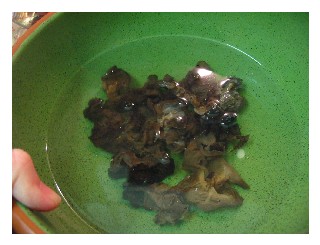 If you are using tree ear mushrooms, set them in hot water to hydrate. These mushrooms are also called black cloud mushrooms and are found at the chinese shops. They add texture and color to your jiaozi but are not absolutely necessary.
If you are using tree ear mushrooms, set them in hot water to hydrate. These mushrooms are also called black cloud mushrooms and are found at the chinese shops. They add texture and color to your jiaozi but are not absolutely necessary.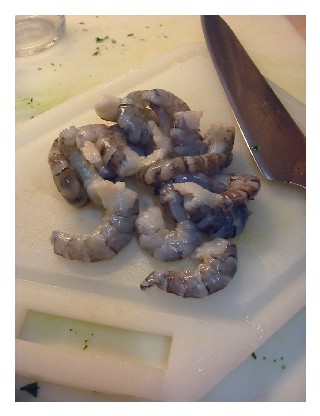 If you decide to make them fancy with shrimp, chop up your shrimp and mince your ginger. This can go straight into the bowl with the ground pork.
If you decide to make them fancy with shrimp, chop up your shrimp and mince your ginger. This can go straight into the bowl with the ground pork. 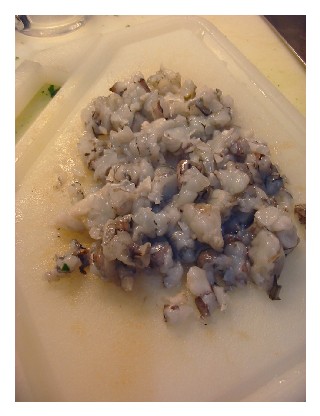 Shrimp is not something we always put into our jiaozi. In fact the only main things you need for good jiaozi is some nice fatty pork and greens.
Shrimp is not something we always put into our jiaozi. In fact the only main things you need for good jiaozi is some nice fatty pork and greens. 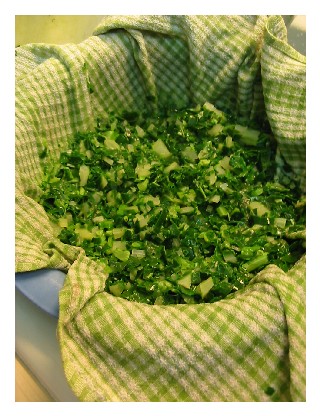 Once the water boils, parboil your greens. This is done by putting the chopped greens into rapidly boiling water all at once, and when it comes to a boil again, quickly turn it into a collander or chinois which has been lined with a clean rinsed dishcloth, and run cold water over it to cool it down completely.
Once the water boils, parboil your greens. This is done by putting the chopped greens into rapidly boiling water all at once, and when it comes to a boil again, quickly turn it into a collander or chinois which has been lined with a clean rinsed dishcloth, and run cold water over it to cool it down completely. 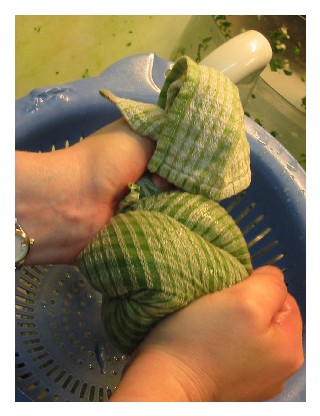 Once that is done, you'll want to twist the towel around and around and squeeze as hard as you can to remove as much liquid as you can from them.
Once that is done, you'll want to twist the towel around and around and squeeze as hard as you can to remove as much liquid as you can from them. 
 Add it to the bowl with the pork and the shrimp.
Add it to the bowl with the pork and the shrimp. Bu this time, your mushrooms should be hydrated.
Bu this time, your mushrooms should be hydrated. Chop them up and add them to the bowl,
Chop them up and add them to the bowl,  along with your seasonings: spring onions or garlic chives if in season, ginger, salt, soy, sugar, sesame oil, and chinese black vinegar.
along with your seasonings: spring onions or garlic chives if in season, ginger, salt, soy, sugar, sesame oil, and chinese black vinegar.  Mix that up with your hands really well. That's your stuffing. Now for the dumpling making: Cut your ball of dough into 4 pieces with the knife. Keep them under a damp towel in their bowl to stop them from drying out while you work. Roll the quarter piece into a snake about 1cm thick, and cut the snake in half lengthwise, then half of that and half of that all along, ending up with 16 small pieces the size of good sized gnocci.
Mix that up with your hands really well. That's your stuffing. Now for the dumpling making: Cut your ball of dough into 4 pieces with the knife. Keep them under a damp towel in their bowl to stop them from drying out while you work. Roll the quarter piece into a snake about 1cm thick, and cut the snake in half lengthwise, then half of that and half of that all along, ending up with 16 small pieces the size of good sized gnocci.  Roll each one out into a flat circle by spinning it along as you give it two or three good rolls. This way your dumpling will be rolled thinner round the edges. It is good to have a nice thick jiaozi skin in the middle, especially if you are going to make guotie with them, which are these very same dumplings which are cooked by frying instead of boiling.
Roll each one out into a flat circle by spinning it along as you give it two or three good rolls. This way your dumpling will be rolled thinner round the edges. It is good to have a nice thick jiaozi skin in the middle, especially if you are going to make guotie with them, which are these very same dumplings which are cooked by frying instead of boiling. 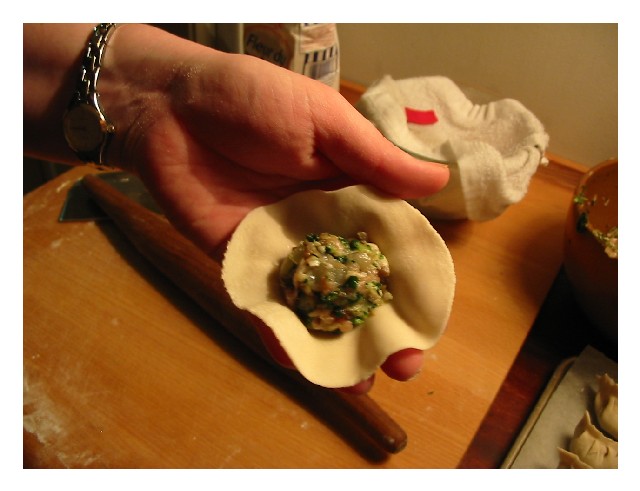 Folding dumplings is just something you have to learn by doing. Many people just fold them in half. The more you make these dumplings, the more you'll fall into your own personal style.
Folding dumplings is just something you have to learn by doing. Many people just fold them in half. The more you make these dumplings, the more you'll fall into your own personal style. 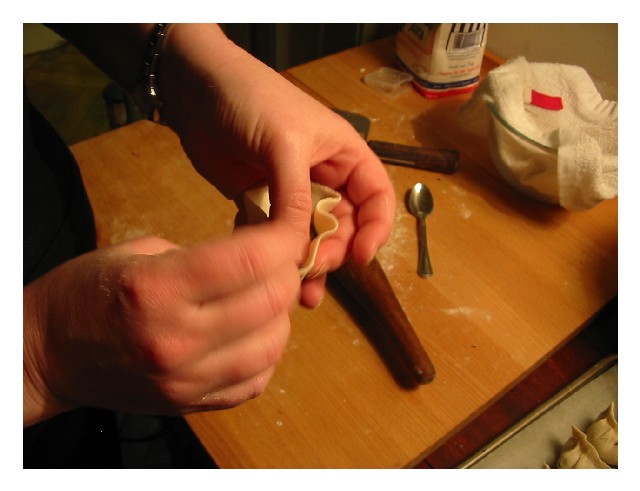 The person who taught me to fold dumplings was my Chinese housekeeper, the one who saved my life when I was living in Beijing. Over the years,
The person who taught me to fold dumplings was my Chinese housekeeper, the one who saved my life when I was living in Beijing. Over the years,  Ive made dumplings with lots of Chinese people and each person has had his or her own style, learned from their family. In Shanghai, they like to make them small, to delicately pop into your mouth.
Ive made dumplings with lots of Chinese people and each person has had his or her own style, learned from their family. In Shanghai, they like to make them small, to delicately pop into your mouth. 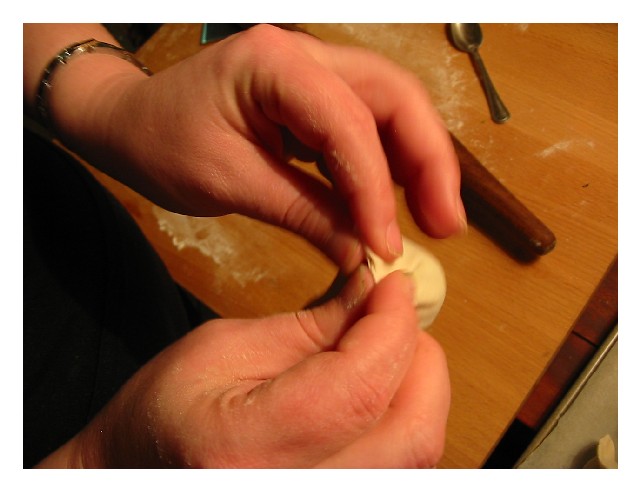 In Beijing, the style is a bigger dumpling that comes to the table freshly boiled in big steaming heaps in the middle of winter. in Hong Kong, where they fry them and often steam them instead of boiling, there again you have a different style.
In Beijing, the style is a bigger dumpling that comes to the table freshly boiled in big steaming heaps in the middle of winter. in Hong Kong, where they fry them and often steam them instead of boiling, there again you have a different style.  The most important thing is to make sure that the stuffing is well sealed in the middle of the dumpling, so that water doesn't leak into them and dilute the flavor. When you make your own dumpling skins, you don't have to wet the edge of the skin to seal it, because it already contains enough moisture and broken glutens to bind together, The skins you work with when they are homemade are more flexible and easier to make into the "purse" shape, sitting upright.
The most important thing is to make sure that the stuffing is well sealed in the middle of the dumpling, so that water doesn't leak into them and dilute the flavor. When you make your own dumpling skins, you don't have to wet the edge of the skin to seal it, because it already contains enough moisture and broken glutens to bind together, The skins you work with when they are homemade are more flexible and easier to make into the "purse" shape, sitting upright.  At this point you can freeze them if you want. Note that the fried dumplings do much better when you have some frozen already, since they don't overcook in the middle all the time when the bottom is browning.
At this point you can freeze them if you want. Note that the fried dumplings do much better when you have some frozen already, since they don't overcook in the middle all the time when the bottom is browning.  To cook by boiling, which is my favorite way because that's what we used to eat in Beijing, you add the dumplings to simmering water, and let them simmer until they float to the top. If the dumplings are frozen and you want to boil them, bring the water to a boil, and then cook it down with a small bowl of cold water twice, bringing the dumplings to boil twice. If you cook these dumplings too long, they will not taste as good - don't overboil them.
To cook by boiling, which is my favorite way because that's what we used to eat in Beijing, you add the dumplings to simmering water, and let them simmer until they float to the top. If the dumplings are frozen and you want to boil them, bring the water to a boil, and then cook it down with a small bowl of cold water twice, bringing the dumplings to boil twice. If you cook these dumplings too long, they will not taste as good - don't overboil them.  Serve them with nice cold Chinese beer, Tsingdao or the likes. For the dipping sauce, in each dipping bowl put 2 Tablespoons Chinese black vinegar, 1 Tablespoon soy sauce, 2 drops of sesame oil, and a 1/4 teaspoon finely minced raw garlic.
Serve them with nice cold Chinese beer, Tsingdao or the likes. For the dipping sauce, in each dipping bowl put 2 Tablespoons Chinese black vinegar, 1 Tablespoon soy sauce, 2 drops of sesame oil, and a 1/4 teaspoon finely minced raw garlic.I hope you like them!
Labels: Spring 06



























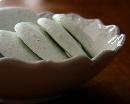








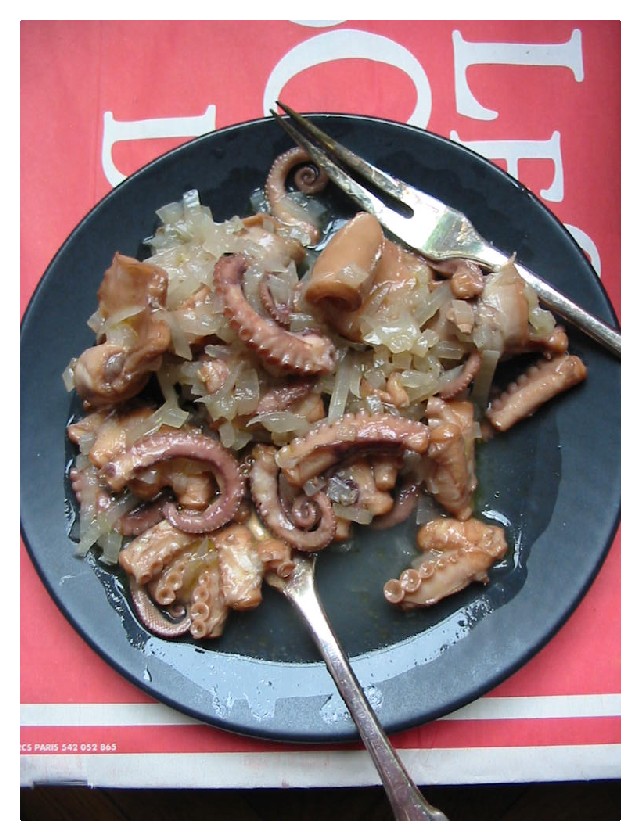


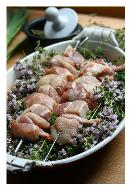












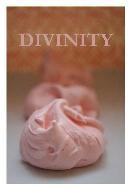
16 Comments:
Lucy, thanks for the tutorial. This is very similar to how we make dumplings at home, although I've never added mushrooms. I'll have to try that. Also, we always add water 3x to the dumplings while cooking; I'm going to try your method and see if I like it better! Perhaps we've been overcooking them all these years.
Thanks Hilary! Let me know how it goes!
So, Lucy...nearly a year later and I am going to try these darling little dumplings! There is no Kim, no Julia, no Tom and no Ali :( so I will have to employ the lusty kneedy hands of my Pierre-Alexandre :) Will get back to you with results, promise.
Little Kiwi Laura
OK, so every muscle in both arms aches from all that kneading and rolling! Even my abs too!! (Alex escaped, as he was working). So, now I see how so many Asian women keep so trim...! Needless to say, it was all worth it, they were a hit with our guests and a nice nostalgic moment for me too :) Definitely will be making these as a party apertiser in the future. Hope all is well,
Bisous,
Laura.
I can not thank you enough for your wonderful, candid discussion. The tips you included are priceless, and I can't wait to try them. I'd love to see an additional discussion on folding, which is my weak point.
these look so wonderful. i make dumplings pretty regularly but never make my own dough and NEVER wrap them as perfectly as you. i need more practice i suppose.
I am getting ready for a cast party and wanted to check ingredients for shrimp dumplings. what a treat to come across this absolutely beautiful presentation! I'm too busy to read more, but will come back soon. thank you!!!
Mary Hepburn
Lucy -- checking back in to let you know that your recipe has replaced my SO's mom's! I like the black vinegar addition, as well as the pork fat (leaf lard here, which probably isn't necessary). The only thing I do differently is use rehydrated shitake mushrooms. I'll have to dry making my own skins next -- last time it was a disaster. We were way too slow at rolling, so it took forever, and we were very irritable by the end.
Dear Hilary,
Rolling dumpliing skins is something that seems hard the first couple of times you do it, but then later you wonder what made you think it was so hard. You get a rhythm, one or two people roll them (a bottle for Alsacian wine works quite nicely as a second rolling pin) and you get more people stuffing them, and there you have it, the batch is done before you know it. Once you get the hang of it you'll like the home made skins better!
hi lucy, i've just discovered your blog and think it is lovely. this post is particularly wonderful as a friend and i are planning a dumpling-making session next weekend. thanks for the tips!
Hi Lucy,
I have read many dumpling recipes online and found yours to be among the best. I have a few questions:
1. I tried making my own skins last week for the first time. Problem is when I rolled it with a rolling pin, the skin took on more of a square/rectangle shape instead of a circle. I need much more practise.
Also, you state in your recipe that the middle of the dumpling skin should be thicker then the edges, does that mean when we roll the skin, we should try to avoid rolling the middle section and concentrate on rolling the outer edges as much as possible?
2. Where does one purchase pork or duck lard?
Thank you for sharing your recipe.
Rbtaipei
Dear RB,
Thank you for your comment, I'm glad you find my recipe to be a good one.
About the rolling out of the skins: first, roll your piece into a ball, and flatten it with a roll from your pin, turning it around once or twice to get is as round as you can. Then roll two or three times around the edges, to work on its roundness. Yes, working around the edges will keep it thicker in the middle. With practice, you'll find that you can get them nice and round.
About the lard or duck fat - You can ask for pork or duck fat from the butcher, and duck fat can also come in cans from the store. If you don't have a ready source, don't worry, if start with nice fatty pork to begin with, your dumplings will turn out quite delicious without the added fat.
Kind regards,
Lucy
Chinese Canadian boy here who stumbled upon your blog looking for congee recipes to soothe tonsillitis.
Your writing personal taste, AND recipes are all phenomenal. I love the pictures on this one and they look like they'd make delicious guo tie. Please never delete the congee one as well.
Thanks, Kevin! Get well soon.
Awesome recipe! They tasted delicious and weren't too hard to make! Thanks :)
Just made these dumplings and they were delicious. I didn't have black vinegar, but, with a couple table spoons of nice balsamic vinegar, they still turned out well. This dish definitely defeated me, in a good way.
Post a Comment
<< Home